IT Professional Resume Examples
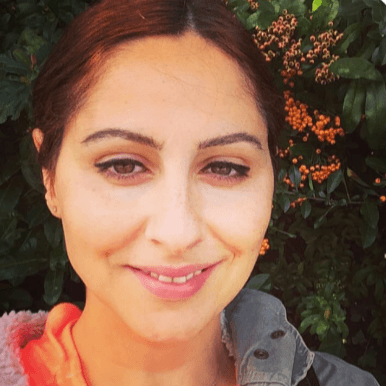
Jul 18, 2024
|
12 min read
Craft a standout IT professional resume: ace your job search with our expert tips.
Rated by 348 people
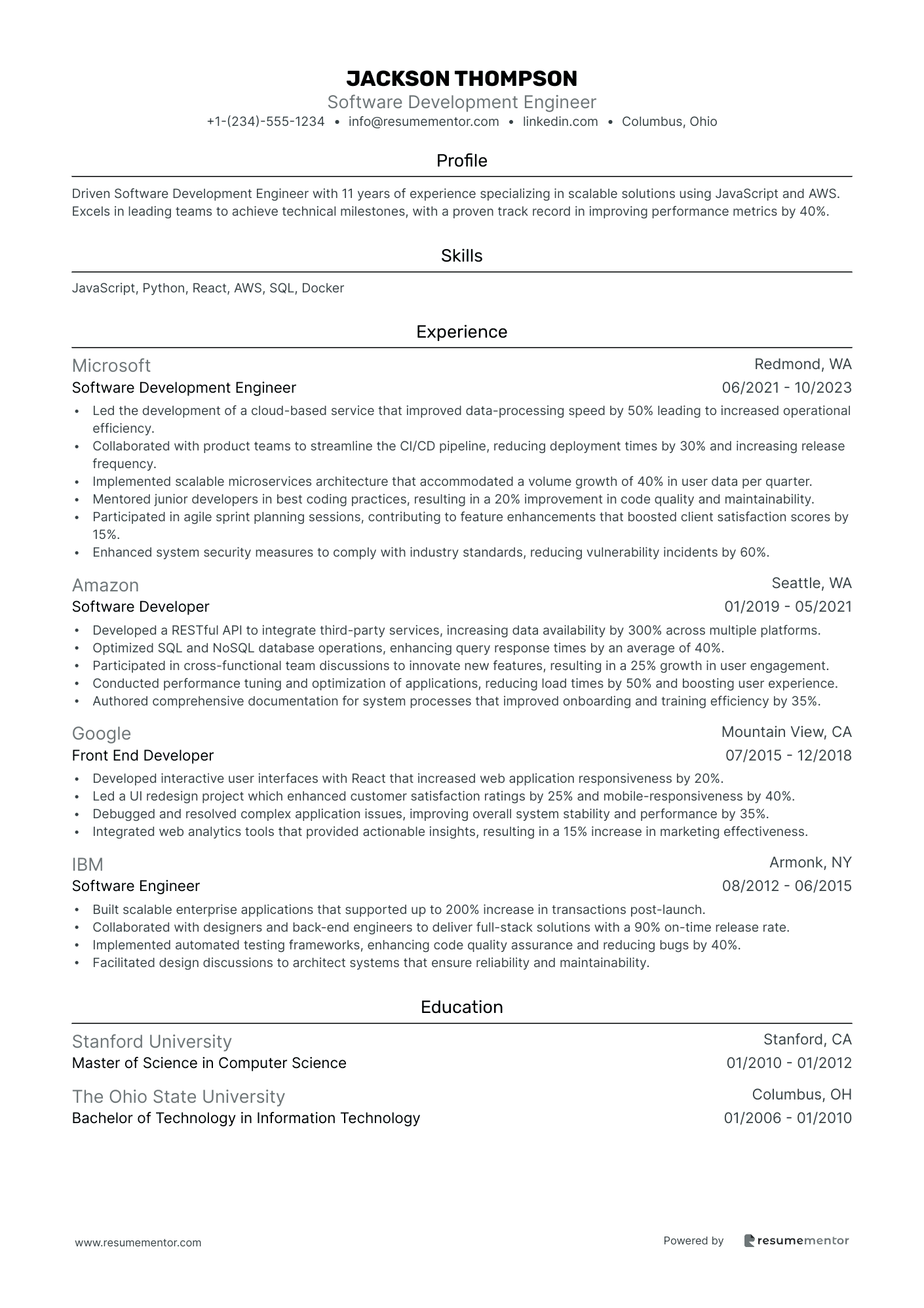
Software Development Engineer

Network Infrastructure Specialist
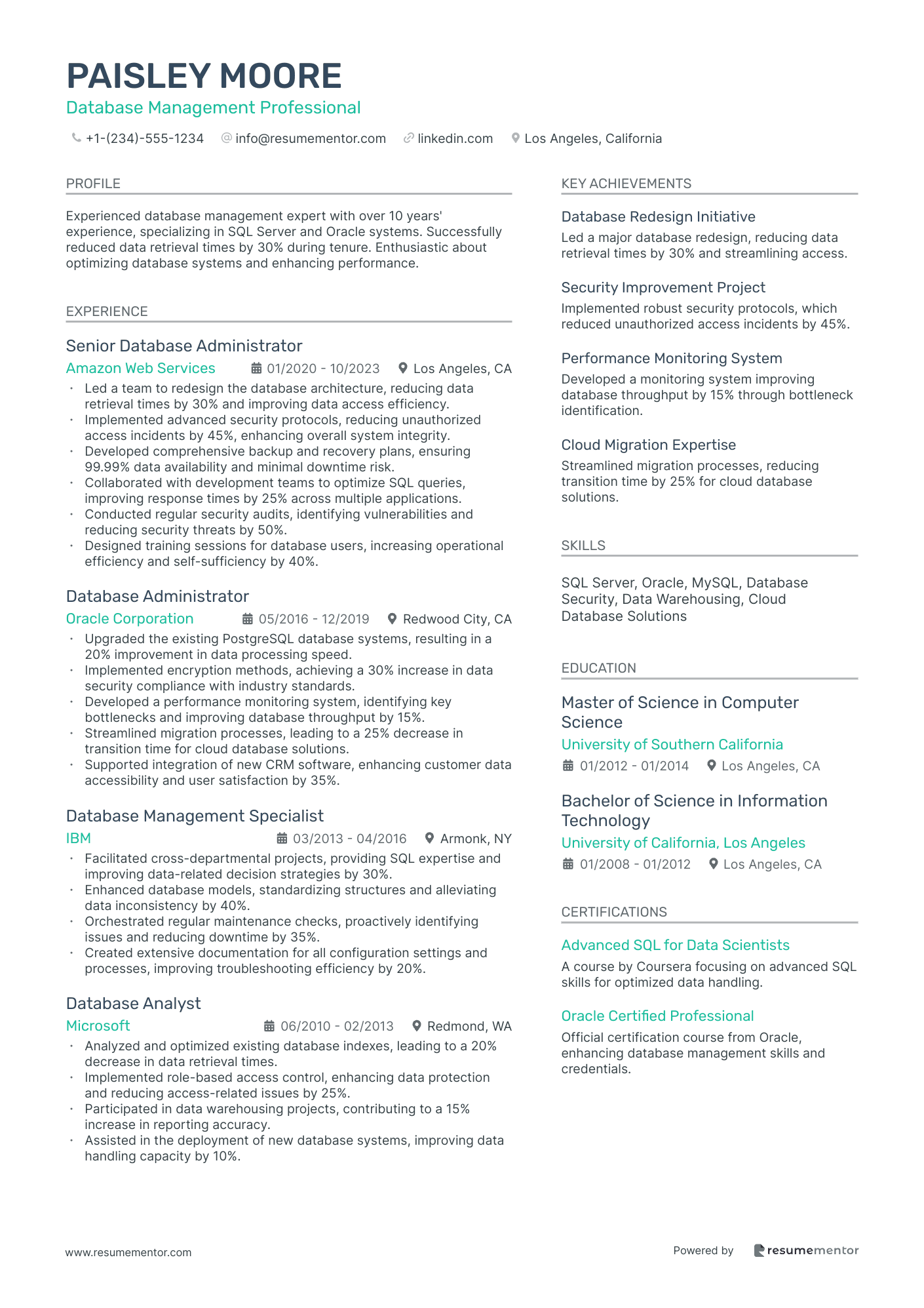
Database Management Professional
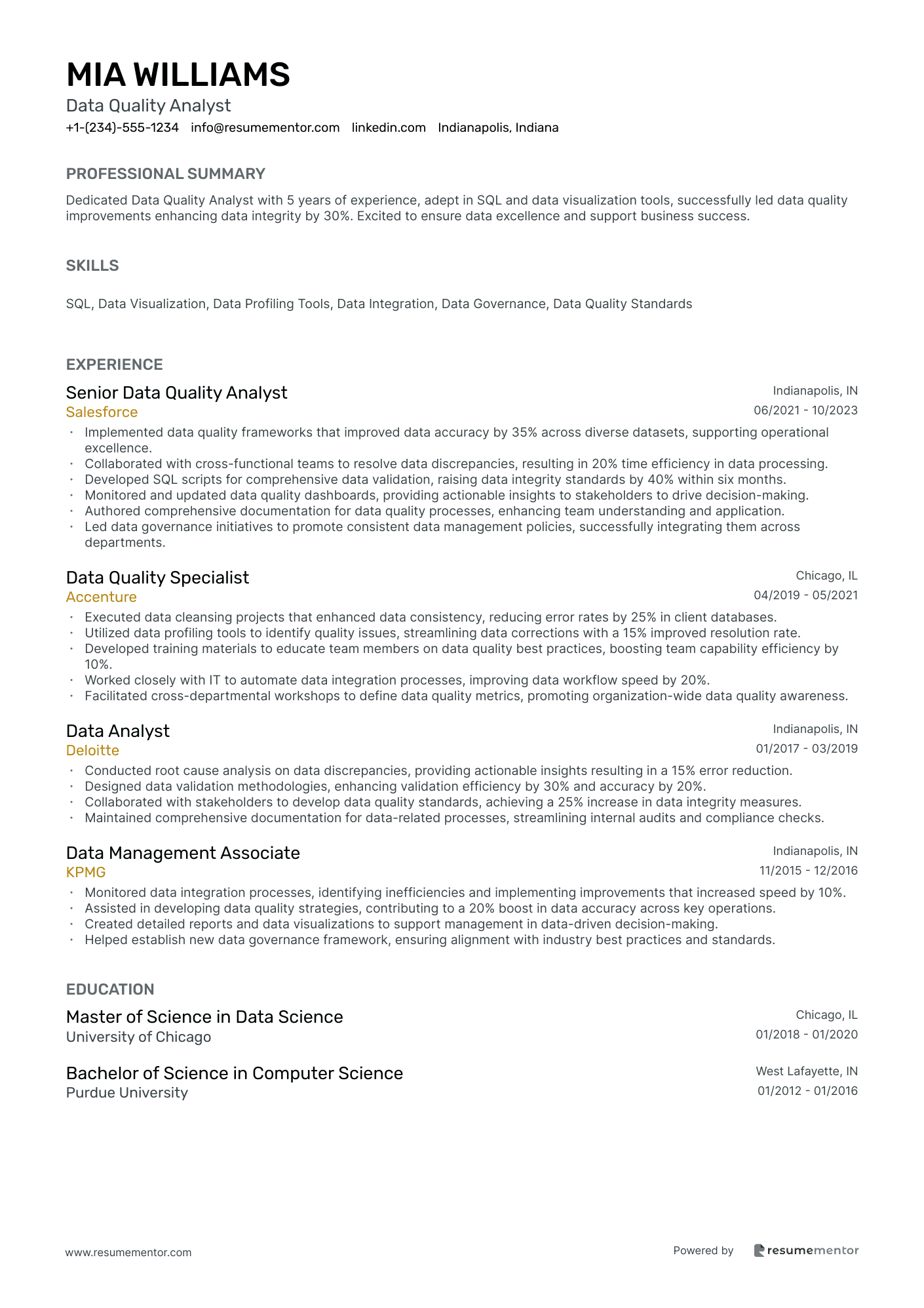
Data Quality Analyst
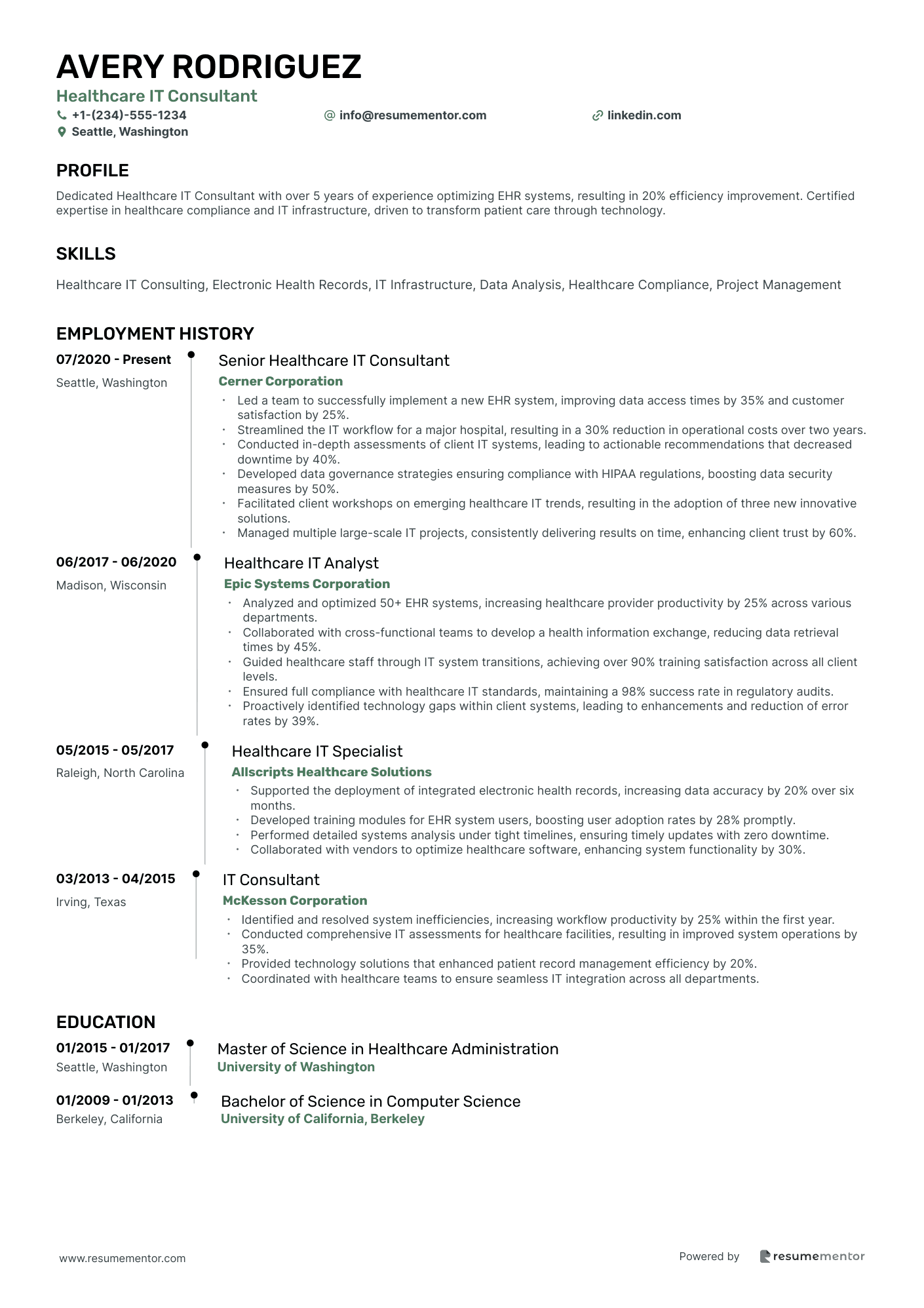
Healthcare IT Consultant
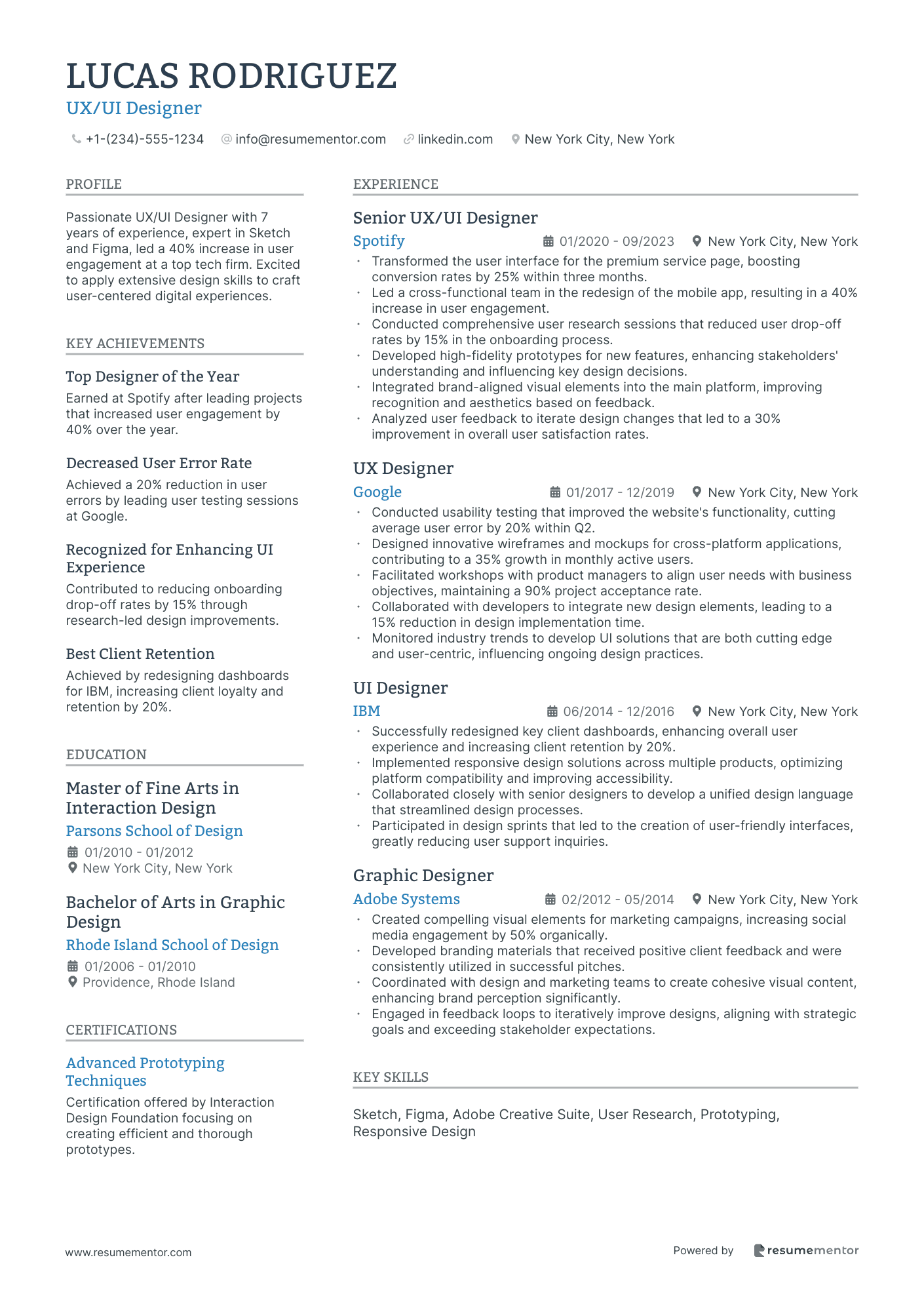
UX/UI Designer

Software Development Engineer resume sample
- •Led the development of a cloud-based service that improved data-processing speed by 50% leading to increased operational efficiency.
- •Collaborated with product teams to streamline the CI/CD pipeline, reducing deployment times by 30% and increasing release frequency.
- •Implemented scalable microservices architecture that accommodated a volume growth of 40% in user data per quarter.
- •Mentored junior developers in best coding practices, resulting in a 20% improvement in code quality and maintainability.
- •Participated in agile sprint planning sessions, contributing to feature enhancements that boosted client satisfaction scores by 15%.
- •Enhanced system security measures to comply with industry standards, reducing vulnerability incidents by 60%.
- •Developed a RESTful API to integrate third-party services, increasing data availability by 300% across multiple platforms.
- •Optimized SQL and NoSQL database operations, enhancing query response times by an average of 40%.
- •Participated in cross-functional team discussions to innovate new features, resulting in a 25% growth in user engagement.
- •Conducted performance tuning and optimization of applications, reducing load times by 50% and boosting user experience.
- •Authored comprehensive documentation for system processes that improved onboarding and training efficiency by 35%.
- •Developed interactive user interfaces with React that increased web application responsiveness by 20%.
- •Led a UI redesign project which enhanced customer satisfaction ratings by 25% and mobile-responsiveness by 40%.
- •Debugged and resolved complex application issues, improving overall system stability and performance by 35%.
- •Integrated web analytics tools that provided actionable insights, resulting in a 15% increase in marketing effectiveness.
- •Built scalable enterprise applications that supported up to 200% increase in transactions post-launch.
- •Collaborated with designers and back-end engineers to deliver full-stack solutions with a 90% on-time release rate.
- •Implemented automated testing frameworks, enhancing code quality assurance and reducing bugs by 40%.
- •Facilitated design discussions to architect systems that ensure reliability and maintainability.
Network Infrastructure Specialist resume sample
- •Enhanced network performance by 30% through the integration of a dynamic routing protocol, improving overall efficiency.
- •Led a team project to redesign the company’s firewall strategy, resulting in a 50% decrease in network vulnerabilities.
- •Configured and maintained over 100 Cisco routers, achieving 99.9% uptime annually.
- •Implemented a monitoring solution that decreased network incidents by 25% and streamlined incident response times.
- •Collaborated with cross-functional teams to align network strategies with evolving business needs, enhancing operational workflows.
- •Conducted regular network audits, which identified gaps and resulted in significant compliance improvements across all departments.
- •Implemented cloud-based network solutions that increased data accessibility by 40% for remote teams.
- •Optimized network throughput by 20% using advanced configurations and state-of-the-art technologies.
- •Managed a virtual networking project on AWS, streamlining operations and reducing overhead costs by 15%.
- •Published comprehensive documentation for network configurations, leading to improved team efficiency.
- •Executed security protocols that met and maintained stringent industry standards, resulting in enhanced data protection.
- •Coordinated with clients to design tailored network solutions, significantly enhancing their service delivery.
- •Lead a project which upgraded the organization’s switch infrastructure, resulting in improved consistency and flexibility.
- •Facilitated a network upgrade that contributed to a 10% increase in service reliability and user satisfaction.
- •Trained junior engineers in advanced network troubleshooting techniques, improving response times by 20%.
- •Assisted in the deployment of new networking hardware, optimizing data transfer rates company-wide.
- •Provided detailed network performance reports, aiding executive decision-making with actionable insights.
- •Executed changes to routing protocols which resulted in a 5% decrease in data packet loss.
- •Performed in-depth analysis of network traffic to pinpoint and ameliorate bottlenecks.
Database Management Professional resume sample
- •Led a team to redesign the database architecture, reducing data retrieval times by 30% and improving data access efficiency.
- •Implemented advanced security protocols, reducing unauthorized access incidents by 45%, enhancing overall system integrity.
- •Developed comprehensive backup and recovery plans, ensuring 99.99% data availability and minimal downtime risk.
- •Collaborated with development teams to optimize SQL queries, improving response times by 25% across multiple applications.
- •Conducted regular security audits, identifying vulnerabilities and reducing security threats by 50%.
- •Designed training sessions for database users, increasing operational efficiency and self-sufficiency by 40%.
- •Upgraded the existing PostgreSQL database systems, resulting in a 20% improvement in data processing speed.
- •Implemented encryption methods, achieving a 30% increase in data security compliance with industry standards.
- •Developed a performance monitoring system, identifying key bottlenecks and improving database throughput by 15%.
- •Streamlined migration processes, leading to a 25% decrease in transition time for cloud database solutions.
- •Supported integration of new CRM software, enhancing customer data accessibility and user satisfaction by 35%.
- •Facilitated cross-departmental projects, providing SQL expertise and improving data-related decision strategies by 30%.
- •Enhanced database models, standardizing structures and alleviating data inconsistency by 40%.
- •Orchestrated regular maintenance checks, proactively identifying issues and reducing downtime by 35%.
- •Created extensive documentation for all configuration settings and processes, improving troubleshooting efficiency by 20%.
- •Analyzed and optimized existing database indexes, leading to a 20% decrease in data retrieval times.
- •Implemented role-based access control, enhancing data protection and reducing access-related issues by 25%.
- •Participated in data warehousing projects, contributing to a 15% increase in reporting accuracy.
- •Assisted in the deployment of new database systems, improving data handling capacity by 10%.
Data Quality Analyst resume sample
- •Implemented data quality frameworks that improved data accuracy by 35% across diverse datasets, supporting operational excellence.
- •Collaborated with cross-functional teams to resolve data discrepancies, resulting in 20% time efficiency in data processing.
- •Developed SQL scripts for comprehensive data validation, raising data integrity standards by 40% within six months.
- •Monitored and updated data quality dashboards, providing actionable insights to stakeholders to drive decision-making.
- •Authored comprehensive documentation for data quality processes, enhancing team understanding and application.
- •Led data governance initiatives to promote consistent data management policies, successfully integrating them across departments.
- •Executed data cleansing projects that enhanced data consistency, reducing error rates by 25% in client databases.
- •Utilized data profiling tools to identify quality issues, streamlining data corrections with a 15% improved resolution rate.
- •Developed training materials to educate team members on data quality best practices, boosting team capability efficiency by 10%.
- •Worked closely with IT to automate data integration processes, improving data workflow speed by 20%.
- •Facilitated cross-departmental workshops to define data quality metrics, promoting organization-wide data quality awareness.
- •Conducted root cause analysis on data discrepancies, providing actionable insights resulting in a 15% error reduction.
- •Designed data validation methodologies, enhancing validation efficiency by 30% and accuracy by 20%.
- •Collaborated with stakeholders to develop data quality standards, achieving a 25% increase in data integrity measures.
- •Maintained comprehensive documentation for data-related processes, streamlining internal audits and compliance checks.
- •Monitored data integration processes, identifying inefficiencies and implementing improvements that increased speed by 10%.
- •Assisted in developing data quality strategies, contributing to a 20% boost in data accuracy across key operations.
- •Created detailed reports and data visualizations to support management in data-driven decision-making.
- •Helped establish new data governance framework, ensuring alignment with industry best practices and standards.
Healthcare IT Consultant resume sample
- •Led a team to successfully implement a new EHR system, improving data access times by 35% and customer satisfaction by 25%.
- •Streamlined the IT workflow for a major hospital, resulting in a 30% reduction in operational costs over two years.
- •Conducted in-depth assessments of client IT systems, leading to actionable recommendations that decreased downtime by 40%.
- •Developed data governance strategies ensuring compliance with HIPAA regulations, boosting data security measures by 50%.
- •Facilitated client workshops on emerging healthcare IT trends, resulting in the adoption of three new innovative solutions.
- •Managed multiple large-scale IT projects, consistently delivering results on time, enhancing client trust by 60%.
- •Analyzed and optimized 50+ EHR systems, increasing healthcare provider productivity by 25% across various departments.
- •Collaborated with cross-functional teams to develop a health information exchange, reducing data retrieval times by 45%.
- •Guided healthcare staff through IT system transitions, achieving over 90% training satisfaction across all client levels.
- •Ensured full compliance with healthcare IT standards, maintaining a 98% success rate in regulatory audits.
- •Proactively identified technology gaps within client systems, leading to enhancements and reduction of error rates by 39%.
- •Supported the deployment of integrated electronic health records, increasing data accuracy by 20% over six months.
- •Developed training modules for EHR system users, boosting user adoption rates by 28% promptly.
- •Performed detailed systems analysis under tight timelines, ensuring timely updates with zero downtime.
- •Collaborated with vendors to optimize healthcare software, enhancing system functionality by 30%.
- •Identified and resolved system inefficiencies, increasing workflow productivity by 25% within the first year.
- •Conducted comprehensive IT assessments for healthcare facilities, resulting in improved system operations by 35%.
- •Provided technology solutions that enhanced patient record management efficiency by 20%.
- •Coordinated with healthcare teams to ensure seamless IT integration across all departments.
UX/UI Designer resume sample
- •Transformed the user interface for the premium service page, boosting conversion rates by 25% within three months.
- •Led a cross-functional team in the redesign of the mobile app, resulting in a 40% increase in user engagement.
- •Conducted comprehensive user research sessions that reduced user drop-off rates by 15% in the onboarding process.
- •Developed high-fidelity prototypes for new features, enhancing stakeholders' understanding and influencing key design decisions.
- •Integrated brand-aligned visual elements into the main platform, improving recognition and aesthetics based on feedback.
- •Analyzed user feedback to iterate design changes that led to a 30% improvement in overall user satisfaction rates.
- •Conducted usability testing that improved the website's functionality, cutting average user error by 20% within Q2.
- •Designed innovative wireframes and mockups for cross-platform applications, contributing to a 35% growth in monthly active users.
- •Facilitated workshops with product managers to align user needs with business objectives, maintaining a 90% project acceptance rate.
- •Collaborated with developers to integrate new design elements, leading to a 15% reduction in design implementation time.
- •Monitored industry trends to develop UI solutions that are both cutting edge and user-centric, influencing ongoing design practices.
- •Successfully redesigned key client dashboards, enhancing overall user experience and increasing client retention by 20%.
- •Implemented responsive design solutions across multiple products, optimizing platform compatibility and improving accessibility.
- •Collaborated closely with senior designers to develop a unified design language that streamlined design processes.
- •Participated in design sprints that led to the creation of user-friendly interfaces, greatly reducing user support inquiries.
- •Created compelling visual elements for marketing campaigns, increasing social media engagement by 50% organically.
- •Developed branding materials that received positive client feedback and were consistently utilized in successful pitches.
- •Coordinated with design and marketing teams to create cohesive visual content, enhancing brand perception significantly.
- •Engaged in feedback loops to iteratively improve designs, aligning with strategic goals and exceeding stakeholder expectations.
Landing an IT job starts with crafting a strong resume. Your technical expertise needs to shine on paper just as brightly as it does in practice, yet turning this into a compelling narrative can often feel like debugging complex code. It’s a challenge to present your achievements in a concise way because technology and roles are always evolving, making it difficult to effectively communicate your most relevant experiences.
This is where a resume template becomes invaluable. A well-structured template organizes your information clearly and professionally, giving you a solid foundation to showcase your skills and experiences. With this structure in place, you can focus on tailoring the content to highlight your real strengths.
Finding that balance between technical jargon and plain language is crucial. Too much industry-specific terminology might confuse hiring managers, while too little can downplay your capabilities. Think of it like tuning a high-performance engine—hitting the right note makes everything run smoothly.
As you dive into this guide, you’ll learn to transform your technical know-how into a compelling career narrative. Your resume tells your professional story in a world eager for the next tech innovation. Let’s start crafting a resume that not only stands out but also resonates in the competitive IT landscape.
Key Takeaways
- Effectively conveying technical abilities and accomplishments on a resume is essential for an IT professional, emphasizing the alignment of your skills with the job description.
- Structuring your resume with a reverse-chronological format helps place the most recent experiences prominently, which is vital in the fast-paced tech industry.
- A well-crafted professional summary offers a quick overview of your key skills and achievements, setting you apart from other candidates.
- A skills-focused section should highlight both soft and hard skills, incorporating keywords that are essential for getting noticed by recruiters.
- Incorporating additional sections like certifications, languages, and volunteer work can enrich your resume, showcasing a broader range of contributions and achievements.
What to focus on when writing your IT professional resume
An IT professional resume should effectively convey your technical abilities and accomplishments to the recruiter while creating a cohesive narrative of your experience and expertise. It’s essential to tailor the resume to the specific IT role you’re applying for, highlighting the most relevant skills and achievements that align with the job description.
How to structure your IT professional resume
- Contact Information—Begin with your name, phone number, email, and LinkedIn profile. Ensure these details are current and professional to facilitate easy communication with potential employers. Including a LinkedIn profile provides recruiters with a broader perspective on your professional background.
- Professional Summary—Follow with a concise overview of your IT expertise and key achievements. This section should directly relate to the role you’re aiming for, showcasing your career highlights and pinpointing what makes you a standout candidate in the IT field.
- Technical Skills—Transition smoothly into listing your core technical skills, such as programming languages, network management, and cloud services. This section serves as a quick reference point for recruiters, underscoring your technical proficiency and relevance to the position.
- Work Experience—Delve into your past roles, emphasizing significant accomplishments and the impact you’ve had in each position. Use this opportunity to showcase how you’ve successfully applied your skills in real-world scenarios, demonstrating both your problem-solving capabilities and your strategic contributions to past employers.
- Education—Support your experience with your educational background, including relevant degrees and certifications. Highlight credentials like a Bachelor’s in Computer Science to emphasize your foundational knowledge and commitment to the IT field.
- Projects and Initiatives—Highlight key projects that illustrate your ability to implement IT solutions and drive innovation. This section helps to reinforce your practical skills, showing potential employers your capability to lead initiatives and deliver technological advancements.
Incorporating some optional sections, like Awards, Publications, or Volunteer Experience, can further enrich your resume, showcasing a broader range of contributions and achievements. Below, we’ll delve deeper into each section to ensure your resume format aligns perfectly with industry standards and effectively captures the recruiter’s attention.
Which resume format to choose
Choosing the right resume format is crucial for crafting an effective IT professional resume. The reverse-chronological format is your best option because it places your most recent experiences up front, giving potential employers immediate insight into your current skills and accomplishments. This is particularly important in the tech industry, where staying up-to-date is essential.
When it comes to font selection, opting for a modern typeface like Lato, Montserrat, or Raleway can enhance the readability and aesthetic appeal of your resume. These fonts convey a contemporary and professional image, aligning well with the innovative nature of the IT field, without overwhelming the reader with unnecessary details.
Saving your resume as a PDF ensures that your document's formatting remains intact across different platforms, which is vital when applying online. PDFs maintain a uniform appearance, so your resume looks polished whether the hiring manager views it on a desktop or a mobile device.
Setting your resume's margins to one inch on all sides provides a clean and balanced layout. This margin size is standard and helps your document appear organized while ensuring that no important information is lost if printed. Keeping these elements in mind will help you create a standout resume that effectively presents your qualifications in the competitive tech job market.
How to write a quantifiable resume experience section
Your IT professional resume experience section plays a crucial role in making a strong impression. Focus on highlighting accomplishments that align with the job you’re applying for. Structure your experience in reverse chronological order, starting with your most recent role, which helps potential employers see your most relevant work first. Cover the last 10-15 years, but ensure the experience included is relevant to the position you're targeting. Tailoring your resume is key, so incorporate keywords and skills from the job ad to seamlessly match what employers are looking for. Use action words like "developed," "optimized," and "implemented" to effectively communicate your impact. Quantifying your achievements is essential to demonstrate your contributions and results in past roles, making your experience tangible and compelling.
- •Optimized network infrastructure, reducing downtime by 30% and increasing system reliability.
- •Implemented a new help desk system, resulting in a 50% improvement in response time.
- •Developed a cybersecurity protocol, decreasing security breaches by 40%.
- •Managed a team of 10 IT professionals, achieving project delivery 20% ahead of schedule.
This experience section effectively uses specific, measurable achievements to clearly demonstrate the impact you had in past roles, which helps create a solid connection with potential employers. Each bullet point builds on the previous ones by consistently using action verbs and quantifiable data to reflect your role in driving success and delivering real results. Aligning your past experiences with the employer’s needs shows you can be a valuable team member who contributes to their objectives. Instead of merely listing duties, this section weaves a narrative of your achievements and growth, making you a standout candidate for the role.
Collaboration-Focused resume experience section
A collaboration-focused software developer resume experience section should effectively showcase how your skills and actions have strengthened teamwork and communication. Begin by centering your experiences on projects where cooperation was crucial to achieving success. Clearly explain your role in each project, demonstrating how you worked seamlessly with others. Highlight specific accomplishments that were possible because of your collaborative efforts, showing tangible results.
Including measurable outcomes can further emphasize your contributions, focusing on how they supported team and project goals. Use action-oriented language, such as "collaborated," "facilitated," or "coordinated," to highlight your teamwork skills. By doing so, you reassure potential employers that you excel in cooperative environments and are drawn to roles where teamwork is essential.
Software Developer
Tech Innovations Inc.
June 2020 - Present
- Collaborated with cross-functional teams to enhance software features, resulting in a 30% increase in user satisfaction.
- Facilitated weekly team meetings to ensure alignment on project goals and foster open communication among team members.
- Developed and implemented process improvements that led to a 15% reduction in project delivery time.
- Coordinated with design and marketing teams to successfully launch a new app feature that increased downloads by 40%.
Result-Focused resume experience section
A result-focused IT professional resume experience section should smoothly highlight how your accomplishments made a significant impact. Begin by stating your role, the name of the company, and your employment dates. Use bullet points to clearly demonstrate your achievements, focusing on how they positively influenced your organization. Incorporate numbers or percentages when possible to effectively illustrate your contributions, such as enhancing processes or saving resources. Avoid vague descriptions, and instead emphasize how you improved efficiency or achieved specific goals.
Each bullet point should kick off with a strong action verb like "developed," "implemented," or "optimized" to convey your initiative and influence. Link your successes by showing how you consistently met or exceeded objectives, tailoring your experiences to the job you're applying for. Align your achievements with the desired skills and responsibilities in the job description to make your resume compelling to potential employers who are seeking candidates who deliver measurable results.
Senior Software Developer
Tech Innovators Inc.
June 2019 - Present
- Led a team of 5 in developing a customer relationship management tool, significantly reducing processing time by 30%.
- Optimized database queries effectively, resulting in a 25% decrease in server load and faster application performance.
- Seamlessly integrated API solutions to enhance data exchange, improving system interoperability and boosting user satisfaction.
- Streamlined deployment processes using continuous integration tools, successfully reducing release times by 40%.
Skills-Focused resume experience section
A skills-focused IT professional resume experience section should clearly showcase the abilities that make you a standout candidate for your desired position. Begin with emphasizing core skills that highlight your unique strengths. While job titles provide context, the real focus should be on your accomplishments and the impact they've had. Use concise language and bullet points to outline your achievements in a way that's easy to digest. Start each bullet with a strong action verb that highlights a particular skill in use, addressing challenges faced, actions taken, and results achieved, to clearly demonstrate your expertise.
Seamlessly integrating quantifiable outcomes into your bullets can also make a significant difference. For instance, if you can quantify improvements to processes, include specifics on time saved or efficiency gains. This strategy helps hiring managers quickly see your most relevant strengths and significant contributions, making your resume more engaging and impactful.
IT Project Manager
Tech Innovations Inc.
June 2020 - Present
- Led a team of 10 software developers to deliver IT projects on time and within budget, improving project delivery success rate by 25%.
- Designed and implemented a new project workflow process that reduced overhead and increased team efficiency by 40%.
- Managed vendor relationships and contract negotiations, which resulted in a cost savings of 15% on average.
- Conducted training sessions for up to 50 new employees, enhancing their performance and integrating them into the company faster.
Technology-Focused resume experience section
A technology-focused IT professional's resume experience section should clearly demonstrate your impact and achievements in previous roles. Start by showcasing the technical skills, software, or tools you've used and explain how they contributed to success. Weave in specific numbers or metrics to clearly illustrate your contributions and tailor each entry to the job you're applying for, emphasizing experiences and skills that align with the job description. This approach helps employers quickly see why you're a perfect fit for the role and how your past experiences translate to their needs.
Continuing with a narrative that highlights both your technical abilities and problem-solving skills, incorporate collaborative projects, leadership roles within tech teams, or innovative solutions you've implemented. Keep sentences concise and direct, ensuring each bullet point captures a significant aspect of your experience. Maintaining consistency in format and language ensures the section flows smoothly, making it easy for hiring managers to find the information they need quickly and efficiently.
Senior Software Engineer
Tech Innovators Inc.
January 2020 - Present
- Led a team of five developers to build a cloud-based application, cutting operational costs by 20%.
- Implemented automation tools, decreasing project completion time by 30%.
- Enhanced system security with advanced encryption, achieving zero data breaches in two years.
- Developed user-friendly interfaces that increased customer satisfaction scores by 15%.
Write your IT professional resume summary section
A well-focused IT professional's resume summary should clearly highlight your key skills and achievements, making you a standout candidate for the role. If you have several years of experience, a resume summary is ideal for giving a quick overview of your career. This approach is different from a resume objective, which outlines your career goals and is more useful if you're just starting out. A well-crafted summary can catch an employer's attention during a quick scan.
Here's an effective example for an experienced IT professional:
What stands out here is the clarity and specificity of your achievements. It seamlessly speaks to both your technical skills and leadership abilities, allowing employers to see how your experience aligns with their needs. Carefully chosen words enhance the narrative, making the summary compelling.
In contrast, a resume profile focuses more on your professional identity and tends to be shorter. Meanwhile, a summary of qualifications highlights major achievements or skills in bullet points. To effectively describe yourself, use action verbs and emphasize quantifiable results. Tailoring each summary to the job makes it concise yet impactful. The overall goal is to quickly show potential employers you're the right fit. This section is a golden opportunity to make a strong first impression.
Listing your IT professional skills on your resume
A skills-focused IT professional resume should clearly highlight your abilities, showing what you can bring to a potential employer. You can showcase your skills in a standalone section or integrate them into your experience or summary, which lets you emphasize your strengths and tailor your resume to the role you're targeting. Soft skills, like communication and teamwork, highlight how you interact with others. On the other hand, hard skills are the specific technical abilities you've honed through training, such as coding or network management. Together, these skills serve as keywords on your resume, an essential tool for getting noticed by recruiters who use these terms in their searches.
When constructing your skills section, clarity and relevance are key. Here’s a structured format that helps keep your resume easy to read.
Skills:
This format helps you directly list the needed technical abilities for IT roles, ensuring your resume remains concise and easy to navigate, which is essential for catching the attention of hiring managers.
Best hard skills to feature on your it professional resume
The hard skills section of your resume should demonstrate your ability to handle technical tasks effectively. This displays your expertise in critical areas for IT jobs. Skills such as coding, system configuration, and data security illustrate your capacity to manage complex responsibilities efficiently.
Hard Skills
- Programming (Java, Python)
- Network Security
- Database Management
- Cloud Computing (AWS, Azure)
- Systems Analysis
- Troubleshooting and Tech Support
- Agile Project Management
- Cybersecurity
- Software Development
- Data Analysis
- IT Infrastructure
- System Integration
- Virtualization Technologies
- Artificial Intelligence and Machine Learning
- DevOps Practices
Best soft skills to feature on your it professional resume
Soft skills are equally important because they show how you manage your work and relationships within a team. These skills demonstrate your adaptability, leadership, and creative problem-solving abilities, all essential for communicating complex ideas effectively in an IT environment.
Soft Skills
- Communication
- Problem Solving
- Critical Thinking
- Teamwork
- Adaptability
- Time Management
- Leadership
- Attention to Detail
- Multitasking
- Conflict Resolution
- Interpersonal Skills
- Creativity
- Negotiation
- Emotional Intelligence
- Decision Making
How to include your education on your resume
The education section of your resume is crucial, especially for an IT professional, as it highlights your foundational skills and knowledge. It's important to tailor this section to the job you are applying for, only including education that is relevant. If your degree comes with honors such as cum laude, be sure to note it as it can set you apart. Including your GPA is often a good idea, particularly if it's 3.5 or higher, but be sure to format it clearly, like this: "GPA: 3.7/4.0."
For listing a degree, provide the degree name first, followed by the institution, location, and graduation date. Here is an incorrect example:
And here is a correct example for a standout IT resume:
The second example is effective because it highlights a relevant degree from a prestigious institution. It lists a high GPA, which demonstrates academic excellence. The absence of unnecessary details helps focus attention on your qualifications that matter most for the job.
How to include IT professional certificates on your resume
Including a certifications-on-resume/'>certificates section in an IT professional's resume is crucial. Highlight your credentials effectively by listing the name of the certificate first. Include the date you obtained the certificate next. Add the issuing organization to complete each entry.
Certificates can also be integrated into the resume header to grasp immediate attention. For instance, a header might read: "Certified AWS Solutions Architect | Certified ScrumMaster | Microsoft Certified: Azure Developer Associate." This gives a quick overview of your qualifications before the recruiter dives deeper into your resume.
Example:
This example stands out because it clearly lists well-known and respected certifications relevant to IT professionals. Each certificate is paired with its issuing organization, lending credibility. The chosen certificates, such as AWS and Azure certifications, highlight the individual’s proficiency with critical cloud technologies.
Extra sections to include in your IT professional resume
Writing an effective resume as an IT professional involves carefully selecting and organizing sections that highlight your skills, experience, and personality. Including additional sections like languages, hobbies, volunteer work, and books can make your resume stand out and add a touch of personality.
Language section—List languages you speak fluently and indicate your proficiency level. This helps show your ability to communicate in diverse settings and may give you an edge in global projects.
Hobbies and interests section—Add hobbies that demonstrate relevant skills or qualities like problem-solving or teamwork. This makes you a more relatable candidate and can provide conversation starters in interviews.
Volunteer work section—Include volunteer experience, specifying the role and organization. Highlighting this section displays your commitment to social responsibility and can demonstrate transferable skills.
Books section—Mention books you've read, particularly those related to IT or personal development. This suggests a commitment to continuous learning and can highlight your interests beyond formal education.
In Conclusion
In conclusion, crafting a standout IT resume is an intricate yet rewarding task. Your ability to effectively display both your technical skills and personal traits can significantly elevate your candidacy in today’s competitive job market. Utilizing a well-structured resume template allows your expertise to shine through a professional layout, making it easier for potential employers to see your strengths. Balancing technical language with readability is key; too much jargon might alienate, while too little could undersell your qualifications. A carefully constructed experiences section will showcase your history of achievements and capabilities, providing quantifiable evidence of your impact in previous roles. Highlighting both hard and soft skills ensures a comprehensive view of your capabilities, catering to both technical demands and team dynamics. The education and certifications sections offer a foundation of credibility, showing your dedication to continuous learning and geographic sensibility to emerging technologies. Extra sections like volunteering, language skills, and hobbies not only enrich your resume but also provide a snapshot of your personality, making you a well-rounded applicant. By focusing on strategic tailoring, every section of your resume can effectively communicate your professional narrative, increasing your chances of landing your desired IT role. Each detail, from the choice of font to the inclusion of additional sections, works in concert to portray you as a qualified, passionate candidate ready to drive innovation in the tech world.
Related Articles

Continue Reading
Check more recommended readings to get the job of your dreams.
Resume
Resources
Tools
© 2026. All rights reserved.
Made with love by people who care.

